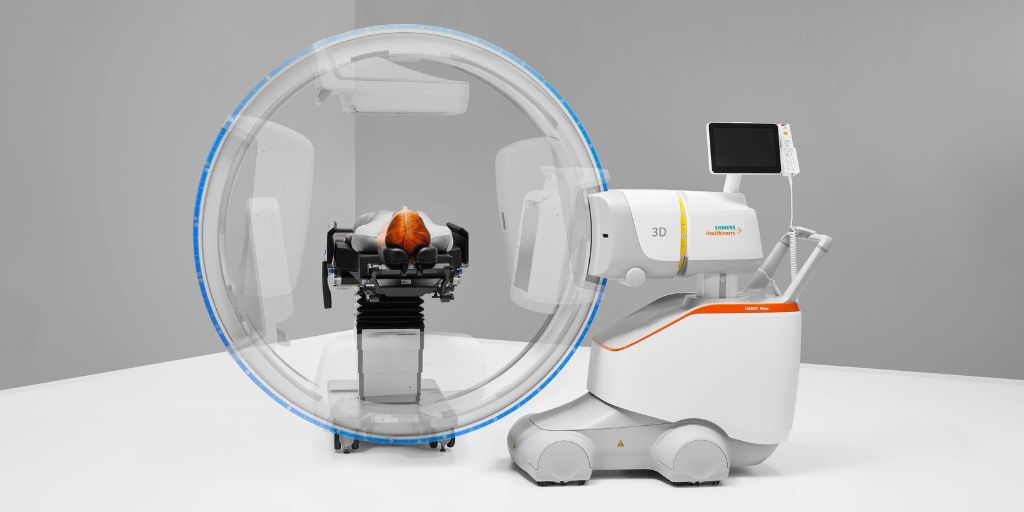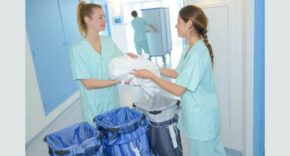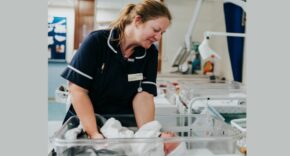
- Fully motorised C-arm system can be operated in sterile field by remote control
- Precise and automated positioning for up to 50 per cent faster intraoperative imaging
- Relief of staff and reduction of idle time in the operating theatre
Siemens Healthineers has developed an automated, self-driving C-arm system for intraoperative imaging in surgery. Equipped with holonomic, omnidirectional wheels that allow precise movements even in the smallest of spaces, Ciartic Move allows easy and accurate positioning. Using a remote control, the system can be moved to previously stored positions with the touch of a button. Automated processes save valuable time with more precise automatic adjustments facilitating reduced imaging times2. Ciartic Move enables around 50 percent time savings during spine, pelvic and distal radius surgery by enabling default positions and settings to be saved and recalled during the procedure.
“In conversations with our customers, the urgent need for a fully automated C-arm system to reduce the burden on surgical staff in the field of trauma surgery became apparent again and again. We have been developing this system over the past ten years and are very pleased to be able to introduce Ciartic Move,” said Giovanni Accardo, Head of Advanced Therapies at Siemens Healthineers Great Britain and Ireland. “The automation of intraoperative imaging, complete remote control and ease of use ensure fast and accurate workflows.”
Ciartic Move focuses on several challenges facing healthcare systems. Due to drastic shortages of medical staff worldwide, it is not uncommon for medical interventions to be postponed – resulting in inefficient clinical processes with longer and unplanned waiting times for patients. In surgery, minimally invasive procedures are the established method of choice, however, this increases demand on clinical staff. Surgical teams tend to be tightly scheduled, with several image-guided procedures performed throughout the day.
Work in operating theatres can be physically demanding with C-arms, weighing up to half a ton, repositioned repeatedly to allow the exact anatomical views needed in real time. With conventional mobile C-arms, this repetitive manual positioning can be time-consuming and prone to error, whilst controlling and moving the device within operating theatres and between rooms requires a great deal of physical effort.
Ciartic Move returns to previously stored positions and settings at the touch of a button at any time during a procedure. Up to 12 process-specific 2D or 3D C-arm positions can be stored – along with the associated image parameters. The system also has an active sensing technology that offers collision protection for greater safety. Touch-sense handles on the back and detector allow for effortless, motor-assisted movements during the procedure and make it easier to steer the system within the operating theatre as well as moving it to another room. In addition, a single person can operate the system remotely, even from the sterile area1. This makes it possible for appropriately trained surgeons or surgical teams to continue working even when personnel with special expertise in intraoperative imaging are not available.
“If surgical staff are absent at short notice, there is always the risk that procedures will have to be postponed,” said Dr Mario Perl, Director of the Department of Trauma Surgery and Orthopaedics, Uniklinikum Erlangen, Germany. “Thanks to Ciartic Move, we can relieve our staff physically and mentally and bridge staff absences due to illness. The automatic return to the pre-determined position that we used before allows us to focus on the patient.”
Dr. Paul A. Grützner, Director of the Department of Trauma Surgery and Orthopaedics, BG Klinik Ludwigshafen, Germany: “We have been involved in the development of Ciartic Move for many years and are delighted that a product has been created that really makes our lives easier. Ciartic Move represents a quantum leap for the workflow in the operating theatre with shorter process times and lower radiation exposure.”
- Remote system operation from the sterile field proven in a cadaveric setting with 10 human specimens, with orthopaedic trauma and spine surgeons, compared with Cios Spin.
- Time savings proven with orthopaedic trauma surgeons in a cadaveric setting with 10 human specimens, compared with Cios Spin.
- Ciartic Move is not available in all countries. Its future availability cannot be guaranteed. The statements of Siemens Healthineers customers described herein are based on results obtained in the customer’s specific environment. Since there is no “typical” hospital or laboratory and many variables exist (e.g. hospital size, sample mix, case mix, level of IT and/or automation adoption), there is no guarantee that other customers will achieve the same results.













